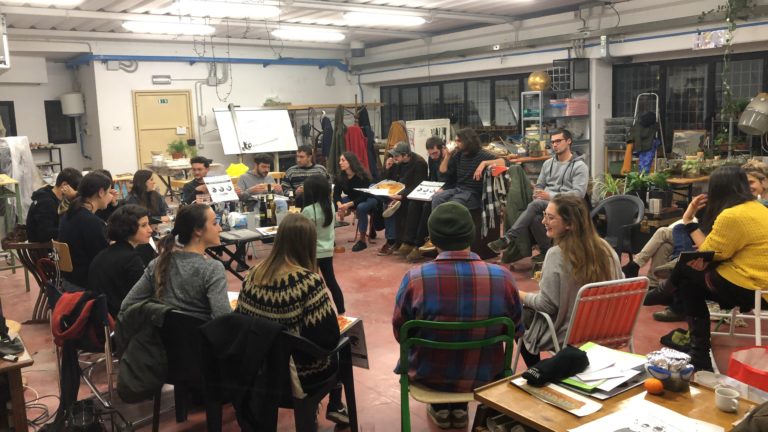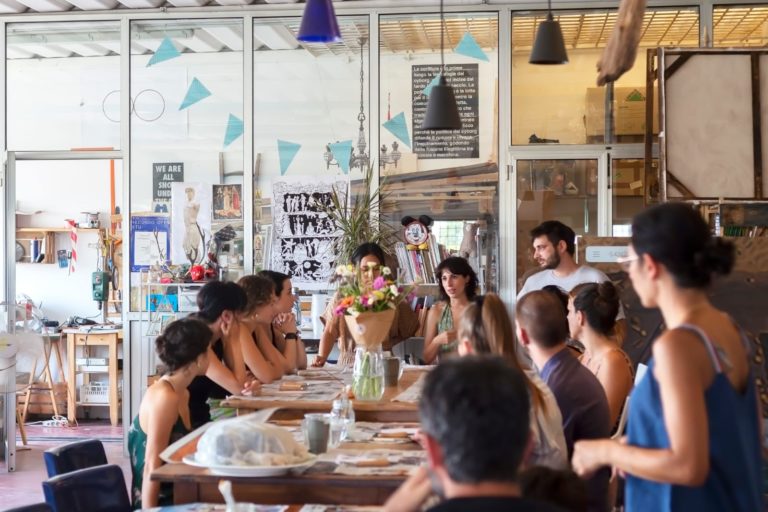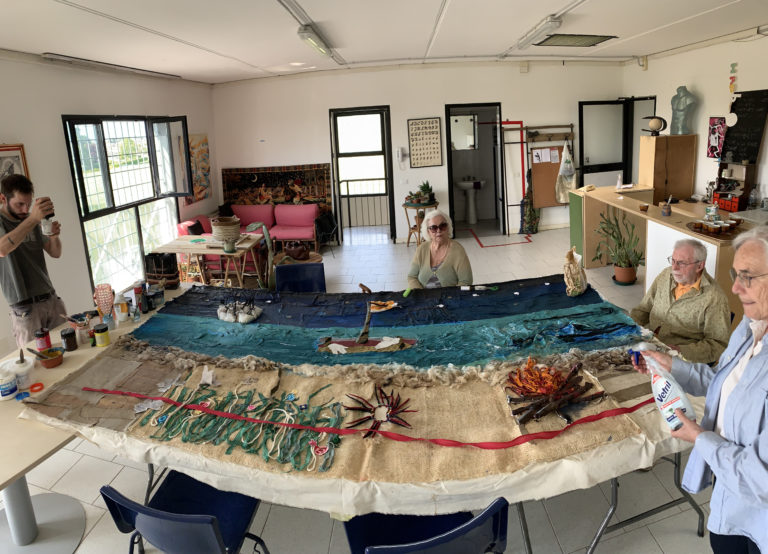Part. 3 of the series: Independent Cultural Spaces in Italy
Author: Matilde Bignotti
The final article in this series focuses on a space that remained informal and undefined from start to finish, and it is these qualities that have given it its unique impact and provide an insightful example. This is not a story of ‘success’ in the common sense as the space closed last June. But it’s not a story of failure either, nor does it aim to provide ‘best practice’ or guideline for running hybrid spaces. Instead, it offers new perspectives on co-creation and what success can mean.

© La Caienna photo archive
The story begins in 2020: the pandemic still loomed large, limiting gatherings and interactions, and Vicenza—a provincial city in Italy’s Veneto region—had never felt so quiet. Even before Covid-19, the city of Palladio was overshadowed by nearby provinces in terms of artistic offerings and youthful energy. Cities like Padua, Venice, and Verona, with their museums, galleries, art collectives, and cultural centres, thrived thanks to their vibrant university life—something Vicenza lacked. Known for its entrepreneurial spirit, Vicenza is characterised by its manufacturing industry and the sprawling industrial estates that, along with the Po Valley countryside, define its outskirts. It was in one of these in-between areas, on the second floor of a disused goldsmith’s workshop, that something new began to take shape: La Caienna.
La Caienna was a cultural space created by a loosely organised group of young artists, creatives, and social workers who needed a space to work. Imagine a 600-square-meter warehouse with large windows and raw walls, hosting over 20 artists and their workspaces, filled with an array of objects and furniture, plants, tools, and instruments brought in by its occupants. At first glance, La Caienna could be seen as just another coworking space, as it wasn’t born out of a common goal or a planned project, nor did it evolve into one. However, this view overlooks what makes this story a compelling example of independent culture: the conditions that allowed it to naturally evolve into an art incubator. These conditions—inclusion, exchange, and informality—were like wild seeds, enabling ideas to grow into new art initiatives, encouraging experimentation and turning individual projects into collective ones.
Creative Chaos in the Living Room
To understand how La Caienna achieved its unplanned impact, we need to take a step back and introduce its precursor: Il Salotto. In 2019, the same building was home to Il Salotto (The Living Room), a studio founded by five visual arts students, used mainly to create scenic installations and occasionally to host friends, events, and performances. It was a young ceramicist, Davide Dalmazio, who joined the group during the pandemic, saw the potential of the large space, and began to transform it. “The space was crying out to be lived in,” he recalls, describing its magnetic and inspiring atmosphere. “The members of Il Salotto weren’t regulars; I often found myself alone in this huge space. So, simply wanting some company while I worked, I began inviting friends and former classmates from the Art Academy to visit.” Enchanted by the space and in need of a place to continue their artistic practice, many asked to join as subtenants. As the space allowed, having other artists involved offered both social and economic benefits, as rent and costs could be shared.
Within a month, the warehouse on the outskirts of Vicenza had attracted a diverse group of creatives and other workers: two painters, a luthier, two carpenters, three curators, a photographer, two musicians, a designer, a graffiti artist, a textile artist, two illustrators, a florist, two social workers, and an event organiser. Il Salotto soon filled up, and a communal workspace formed around the sofas. The lack of selection criteria or expectations created a mix of disciplines that, in retrospect, marked the first step in the space's evolution: inclusivity. “The people who joined shaped the space, like pieces of a puzzle: each person brought different skills and practices that complemented each other. Although it happened spontaneously, the decision to bring together artists and non-creatives was a winning formula,” says Davide. There was no plan or programme at that stage; everything came together naturally, allowing the potential of such a mix to grow organically.

© La Caienna photo archive
Indeed, the mix of skills in this close-knit, informal, and creative environment naturally planted the seeds for the art incubator to develop around exchange and collaboration. Those who spent their days at Il Salotto working on their projects were never truly alone—they were part of a constant exchange of ideas, feedback, and discussion that went beyond their individual work. Far from being a quiet coworking space, Il Salotto fostered a process of mutual inspiration that encouraged everyone to step out of their comfort zones and try new things. As well as sharing ideas and experiences, experimentation was also encouraged through access to shared materials and expertise. The diversity of artistic practices at Il Salotto brought access to different tools, materials, and most importantly, a willingness to share knowledge. The small size of the group facilitated experimentation, allowing members to pool resources to acquire unique materials to explore new ideas.
Interestingly, it was the informality of Il Salotto that made the space fertile enough for inclusivity and exchange to flourish and new art projects to emerge. As Davide Sozio, one of the painters, puts it, it was the casual, everyday life shared at Il Salotto that truly unlocked the potential of this eclectic group: “The real magic of the place was in the daily conversations—over coffee or while relaxing on the couches after a day’s work. That’s where reflections and discussions about art came alive, or where ideas emerged that eventually led some of us to collaborate.”
La Caienna: A Winning Formula’s Rise and Fall
It was during these informal moments that the residents of Il Salotto realised that they had become more than just a loose group working in the same space. The initial identity of the place shifted as casual conversations over coffee gradually gave way to collaborative projects and events, and individual efforts became more experimental and collective. Aware of these changes, the group adopted a new name in early 2022: La Caienna. Inspired by Caiena, the name of a neighbourhood in the 1940 and 50s, known at the time as one of the most notorious and dangerous areas in Vicenza. As the pandemic restrictions eased, the group turned outwards, and what had been incubated and tested in the space began to grow beyond its walls. The ceramist, for example, after testing in the warehouse, began to offer workshops in schools. Similarly, the 'Meeting Gardens' series of events, initiated by the curators' collective at La Caienna, expanded into the city. The music group Moringa Clave also found inspiration for its identity and artistic direction in the warehouse.
The mix of creative and non-creative members began to blossom into new events and projects. Inside and outside La Caienna, its members presented their work to the public and collaborated with other initiatives in the city. The opening up of the space to reveal its creative and social resources attracted the attention of social cooperatives and initiatives, which proposed art therapy projects. Several artists, supported by the expertise and networks of the social workers, got involved in social projects and art therapy laboratories involving different groups from the city—from Parkinson patients, to gypsy children, from the homeless, to young people who had dropped out of school.

© La Caienna photo archive
Given the success of these developments, it might have seemed natural for La Caienna to grow further: to formalise itself as a cultural association, to apply for funding, and to expand its network. However, the same elements that had initially encouraged experimentation and collaboration at first—openness, spontaneity, and informality—became barriers to its long-term sustainability. Different visions for the future of La Caienna clashed, and the lack of internal organisation and a pre-established goal made it difficult to address and make a collective decision. Moreover, some members were only interested in coworking, while others took their projects elsewhere as the chaotic and informal environment became a limit to their professional growth. A year after La Caienna’s launch, the initial enthusiasm that had sustained the group began to fade, leaving it vulnerable to a lack of structure, leadership, and a clear plan. As internal tensions mounted and new costly problems with the building arose, the next direction was clear to all and La Caienna officially came to an end.
The Impactful Heritage of a Successful Failure
In a world where only long-lasting projects are considered successful, it’s easy to label La Caienna a failure and focus on what might have made it last. But fixating on the “do’s and don’ts” of creating lasting cultural projects sometimes overlooks the richer reflections that this experience offers. First, what unfolded spontaneously in that warehouse in Vicenza shows the powerful potential of freedom, inclusivity, and sharing in artistic experimentation. This unintentional experiment illustrates the benefits and risks of hybridity and independence, and shows that whatever the future holds, its creative impact remains significant.
Secondly, its conclusion suggests a more holistic approach, as described by its initiator, Davide Dalmazio: “This whole experience is a lesson in spontaneity and acceptance. The group came together naturally, and the projects evolved without any plans or expectations. La Caienna was meant to be an informal, chaotic incubator, and that’s where its value lay. When we started discussing visions and responsibilities, we were forcing it out of its nature. It ran its course and naturally ended when its time was up.” Indeed, the end of La Caienna has encouraged its members to flourish beyond its walls, finding new directions and forms to make Vicenza more artistically dynamic. Meeting Gardens, for example, has expanded its presence and events, Moringa Clave has become a well-known band in the city, and the art therapy workshops have continued. Some former members have even opened a new creative space in the centre of Vicenza, Magazzini Primo Tempo, which builds on La Caienna’s strengths and addresses its weaknesses.
Published on October 29th, 2024
About the author:
Matilde Bignotti is an Italian freelance event curator, writer, and coordinator of community-based projects. In the Netherlands, Matilde has collaborated with institutions such as Centraal Museum, Utrecht University and DeVoorkamer in writing and facilitating programs that generate inclusivity through creativity and co-curation.